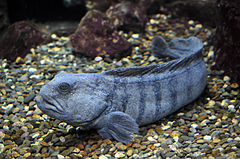Atlantic wolffish
| Atlantic wolffish | |
|---|---|
 |
|
| Scientific classification | |
| Kingdom: | Animalia |
| Phylum: | Chordata |
| Class: | Actinopterygii |
| Order: | Perciformes |
| Family: | Anarhichadidae |
| Genus: | Anarhichas |
| Species: | A. lupus |
| Binomial name | |
|
Anarhichas lupus Linnaeus, 1758 |
|
The Atlantic wolffish (Anarhichas lupus), also known as the seawolf, Atlantic catfish, ocean catfish, devil fish, wolf eel (the common name for its Pacific relative), woof or sea cat, is a marine fish of the wolffish family Anarhichadidae. The numbers of the Atlantic wolffish are rapidly being depleted, most likely due to overfishing and bycatch, and is currently a Species of Concern according to the National Oceanic and Atmospheric Administration's National Marine Fisheries Service.
Apart from their unique appearance wolffish are distinguished by the natural antifreeze they produce to keep their blood moving fluidly in their very cold habitat, involvement by both the male and female in brood bearing, and the large size of their eggs. They are also an important factor in controlling green crab and sea urchin populations, which can become overly disruptive to habitats if left unchecked. Wolffish population success is also an important indicator of the health of other bottom-dweller populations, such as Atlantic cod.
In spite of its large size, the Atlantic wolffish has retained the bodily form and general external characteristics of small blennies (Blennioidei). The largest specimen recorded measured 1.5 m (5 ft) long and weighed almost 18 kg (40 lb). Its body is long, subcylindrical in front, compressed in the caudal portion, smooth and slippery, the rudimentary scales being embedded and almost hidden in the skin. Atlantic wolffish vary in color, usually seen as purplish-brown, a dull olive green, or blueish gray. An even dorsal fin extends the whole length of the back, and a similar fin from the vent to the caudal fin, as in blennies. The pectorals are large and rounded and the pelvic fins are entirely absent. Its obtuse, eel-like body type makes the fish swim slowly, undulating from side to side, like an eel.
...
Wikipedia
